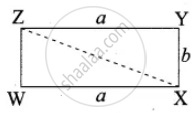Advertisements
Advertisements
Question
In the rectangle WXYZ, XY + YZ = 17 cm, and XZ + YW = 26 cm. Calculate the length and breadth of the rectangle?

Solution
Let the length of the rectangle be “a” and the breadth of the rectangle be “b”.
XY + YZ = 17 cm
b + a = 17 ...(1)
In the right ∆WXZ,
XZ2 = WX2 + WZ2
(XZ)2 = a2 + b2

XZ = `sqrt("a"^2 + "b"^2)`
Similarly WY = `sqrt("a"^2 + "b"^2)`
⇒ XZ + WY = 26
⇒ `2sqrt("a"^2 + "b"^2)` = 26
⇒ `sqrt("a"^2 + "b"^2)` = 13
Squaring on both sides
a2 + b2 = 169
(a + b)2 – 2ab = 169
172 – 2ab = 169
⇒ 289 – 169 = 2ab
⇒ 120 = 2ab
⇒ ab = 60
a = `60/"b"` ...(2)
Substituting the value of a = `60/"b"` in (1)
`60/"b" +"b"` = 17
b2 – 17b + 60 = 0
(b – 2) (b – 5) = 0
b = 12 or b = 5

If b = 12
⇒ a = 5
If b = 6
⇒ a = 12
Length = 12 m and breadth = 5 m
APPEARS IN
RELATED QUESTIONS
Sides of the triangle are 7 cm, 24 cm, and 25 cm. Determine whether the triangle is a right-angled triangle or not.
In the adjacent figure, ABC is a right angled triangle with right angle at B and points D, E trisect BC. Prove that 8AE2 = 3AC2 + 5AD2

In a ∆ABC, AD is the bisector of ∠BAC. If AB = 8 cm, BD = 6 cm and DC = 3 cm. The length of the side AC is
Check whether given sides are the sides of right-angled triangles, using Pythagoras theorem
8, 15, 17
Check whether given sides are the sides of right-angled triangles, using Pythagoras theorem
30, 40, 50
Check whether given sides are the sides of right-angled triangles, using Pythagoras theorem
9, 40, 41
Choose the correct alternative:
In right angled triangle, if sum of the squares of the sides of right angle is 169, then what is the length of the hypotenuse?
Choose the correct alternative:
In ∆ABC, AB = `6sqrt(3)` cm, AC = 12 cm, and BC = 6 cm, then m∠A = ?
In ΔABC, AB = 9 cm, BC = 40 cm, AC = 41 cm. State whether ΔABC is a right-angled triangle or not. Write reason.
In a right angled triangle, right-angled at B, lengths of sides AB and AC are 5 cm and 13 cm, respectively. What will be the length of side BC?
